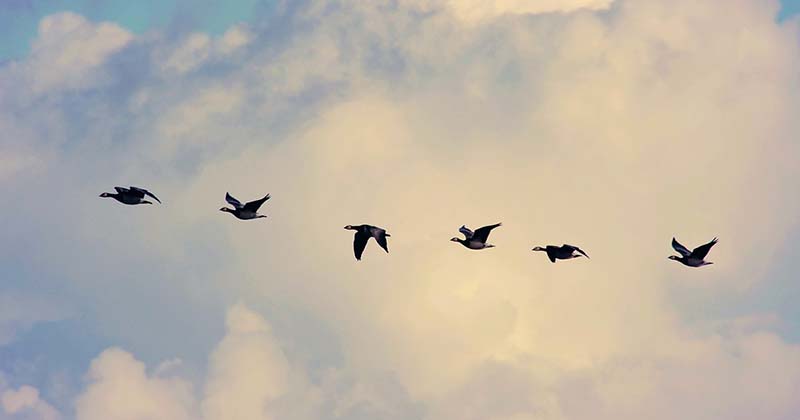It’s that time of year when we remind you to prepare for spring breeding season. Some nesting birds began scouting nest sites in Texas in January. After wintering in Brazil, Bolivia, and parts of Peru, purple martins begin making their way to North America to breed, with Texas being one of the first stops. But how do they know how to get here? We have the luxury of maps, compasses, GPS, and the occasional frantic call to a friend when we’re lost, but how do birds know which way to migrate?
The navigational skills of birds
“Migrating birds can cover thousands of miles in their annual travels, often traveling the same course year after year with little deviation. First-year birds often make their very first migration on their own. Somehow they can find their winter home despite never having seen it before, and return the following spring to where they were born.” – All About Birds
Birds, it’s believed, use a variety of navigation tools to migrate including gathering information from the sun and stars. Seasonal weather patterns, routes that offer stopover locations with food supplies, and even smells may play a role in bird migration. Although how birds navigate is not fully understood, research increasingly indicates that bird navigation is tied to Earth’s magnetic fields.
Bird navigation and magnetic fields
A study published in 2021, showed that migratory birds use Earth’s magnetic fields to establish their position and even when blown far off course they can get back on track. (If you’re using a compass, you’re also using magnetic fields.) Researchers further found that a protein in a bird’s eye makes it sensitive to magnetic fields. As The Wildlife Society explains:
“Physicists have hypothesized since the 1970s that a light sensitive molecule in birds’ eyes helps them sense the earth’s magnetic field through quantum mechanics, the math that describes to process of atoms and electrons. But in 2021, scientists were able to put the idea to the test, measuring the protein in European robins’ (Erithacus rubecula) retinas. They showed that in birds that migrate like the robins, the proteins were more magnetically sensitive than birds that don’t migrate like chickens.”
In addition to the eye protein, researchers have also found that pigeons and some other birds have a small spot on their beaks that contain magnetite. As explained in “How Do Birds Navigate?”:
“Magnetite is a magnetized rock, which may act as a tiny GPS unit for the homing pigeon by giving it information about its position relative to Earth’s poles. Researchers have also found some specialized cells in birds’ eyes that may help them see magnetic fields.
“It is thought that birds can use both the beak magnetite and the eye sensors to travel long distances over areas that do not have many landmarks, such as the ocean.
“In humans, deposits of magnetite have been found in bones in our noses. Do you think that we use Earth’s magnetic field to know which way we are headed?”
Teaching migration routes
While smaller birds my use magnetic fields, larger birds are often taught their routes. Research has found that younger whooping cranes, for example, learn migration routes from older birds. Larger birds have also been taught new migration routes by humans. In what became known as “Operation Migration,” ultralight aircraft were used to help reintroduce endangered birds to native habitats by teaching them migration routes. This effort was given the Hollywood treatment in the 1996 film “Fly Away Home.”
Preparing for bird spring breeding season
The birds are on their way, are you ready? Migrating is no easy task. If the weather takes a turn or hunger sets in, there’s no Buc-ees to roll into to wait out the rain or grab a breakfast taco. After a long, hard journey make sure you’re ready with a warm Texas welcome. Here are a few reminders of what you can do right now:
- Prepare nest boxes. Make sure nest boxes are well-maintained and positioned at the proper height.
- Create brush piles. Brush piles offer shelter and safe havens for all manner of birds, as well as other small critters.
- Set up supplemental feeding. From a 2-pound songbird bird feeder to a 200–pound turkey feeder, well-placed supplemental feeders are a relatively easy and effective way to provide supplemental food for birds
- Book Landmark for your spring bird survey. The Landmark Wildlife Management Breeding Bird or Spring Bird Surveys are typically conducted between April 1 and June 15, during the peak of the breeding season. Our surveys slots book early, so don’t delay in getting on the schedule.
For more, check out Prepare Now for Spring Breeding Season in Texas.









